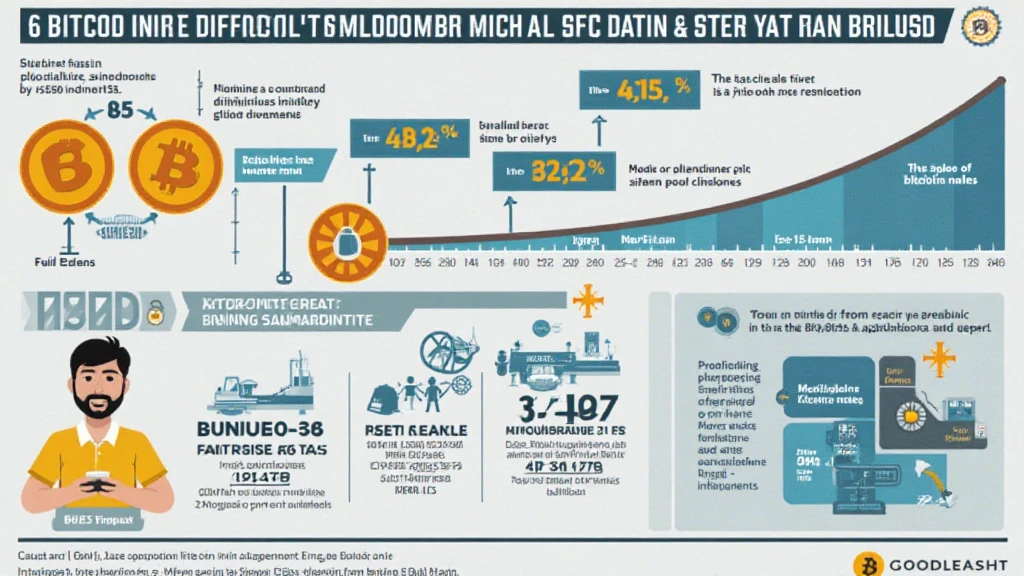Understanding Bitcoin Mining Difficulty Adjustments
With the rapid growth in Bitcoin adoption and the increasing number of miners, understanding the nuances of Bitcoin mining difficulty adjustments has never been more crucial. As of 2024, the total number of active Bitcoin wallets surpassed 500 million, highlighting the expanding user base. However, many still ponder: how does Bitcoin maintain its equilibrium through these adjustments, and why does it matter?
What Are Bitcoin Mining Difficulty Adjustments?
Bitcoin mining difficulty adjustments are mechanisms that ensure the network’s consistency in generating blocks approximately every 10 minutes. The adjustments occur every 2,016 blocks, which is roughly every two weeks. In essence, this system responds to the total computing power (or hash rate) dedicated to mining. If more miners join the network, the difficulty increases, making it harder to mine new blocks. Conversely, if miners exit the network, the difficulty decreases. Here’s the catch: these adjustments help stabilize the Bitcoin economy by regulating the supply of new blocks, which is vital for maintaining market equilibrium.
How Difficulty Adjustments Work
- Each block mined contributes to the cumulative mining history.
- Upon reaching 2,016 blocks, the Bitcoin network assesses the time taken to mine these blocks.
- If the time was less than 20160 minutes, difficulty increases; if more, difficulty decreases.
Visualizing this process is not unlike a bank adjusting interest rates based on economic activity. When there’s too much liquidity (more miners), the system tightens to maintain stability.

The Importance of Mining Difficulty
Why should miners care about these adjustments? The answer lies in profitability. As the mining difficulty increases, the competition among miners ramps up, directly affecting earnings. For instance, miners leverage specialized hardware to achieve higher hash rates, which in turn enables them to maintain profitability despite rising difficulty. Recent data suggests that as of early 2024, miners using more advanced ASIC models have improved profitability margins by approximately 30%, even amidst higher difficulty levels.
Impacts on Miners
- Higher costs for equipment to maintain competitive hash rates.
- Fluctuating profitability margins based on network conditions.
- The necessity for strategic planning regarding energy consumption and operational costs.
Furthermore, miners are not just individuals. According to reports from hibt.com, mining farms have gained prominence in Vietnam, aligning with the country’s growing crypto user base, which saw a 15% increase in 2023. These farms face unique challenges with adjustments—primarily how quickly they can adapt to new difficulty levels.
Global Bitcoin Hash Rate Trends
The global hash rate is a critical factor that influences the mining difficulty adjustments. In 2024, the international Bitcoin hash rate surged by 25%, reflecting increased miner participation. This growth affects difficulty adjustments and indicates higher total mining competition.
Correlation with Difficulty
- As the hash rate increases, so does the difficulty.
- For example, in late 2023, an uptick in mining operations resulted in a difficulty increase of 12%.
In Vietnam, local miners contribute to this global hash rate increase, particularly in regions where electricity is cheaper, enabling them to sustain their operations despite escalating difficulty. The balance between energy costs and mining profitability remains quintessential in this market.
Future Projections for Bitcoin Mining Difficulty
With Bitcoin’s halving event expected in 2024, the mining difficulty adjustments will play a significant role in shaping the future landscape of the Bitcoin economy. Historically, halving events lead to dramatic shifts in difficulty due to the reduced block rewards.
Potential Changes Ahead
- A likely increase in mining difficulty as more miners attempt to capitalize on potential rewards.
- Increased innovation in mining technology and energy efficiency solutions.
Moreover, this projection goes hand in hand with the rising importance of tiêu chuẩn an ninh blockchain. Miners and investors alike must stay updated on security standards and ensure compliance with evolving regulations.
Strategies for Miners in Vietnam
For miners operating in Vietnam’s dynamic market, maintaining awareness of difficulty adjustments is critical. Here are some practical strategies to navigate this landscape:
- Invest in high-efficiency mining equipment.
- Form alliances with local energy providers for better rates.
- Diversify mining operations to include altcoins with lower difficulty as a supplement to Bitcoin mining.
Leveraging Data Analytics
Using real-time data analytics tools can help miners predict and respond to market changes swiftly. Miners can analyze trends and adjust strategies accordingly, maximizing profitability amidst shifting difficulties.
Conclusion: Navigating the Future of Bitcoin Mining
As we delve deeper into 2024, understanding Bitcoin mining difficulty adjustments will become increasingly essential for miners striving to remain competitive. Adapting to market changes, understanding local and global trends, and leveraging innovative strategies align with the evolving landscape of cryptocurrency mining. No matter where you stand, staying informed and agile in this industry will ultimately determine success.
For further insights into the crypto market, feel free to connect with us at cryptocoinnewstoday. Always remember, these insights serve as a guide, and consulting local regulators is advisable before making financial decisions.
Written by John Doe, a blockchain and cryptocurrency expert with over 15 published papers in the field and extensive experience in auditing well-known projects.





